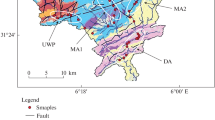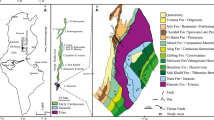Abstract
An association between clay minerals and rock type is recognized in the rocks of an interlayered sequence of fossiliferous shaly, sandy bioclastic, and cherty limestone, dolomitic limestone, calcareous and dolomitic quartzite, and quartzite that form a portion of the lower part (Pennsylvanian age) of the Oquirrh formation in the northern Oquirrh Range, Utah. These sedimentary rocks are largely of clastic origin and range from fine- to coarse-grained. In part they are cross-bedded, and fossils are locally abundant. Calcite-rich rocks predominate (78 percent) over dolomite- and quartz-rich rocks (17 and 5 percent, respectively). Clay minerals constitute less than one percent in quartzite and range from one to five percent in some limestones.
Clay minerals and rock types are commonly observed in the following associations: Illite and chlorite occur in limestone; illite, chlorite, and mixed-layer clay occur in cherty, bioclastic, and sandy limestone and in calcareous quartzite; chlorite and illite commonly are present in dolomitic quartzite; chlorite, illite, and mixed-layer clay are found in dolomitic limestone; and kaolinite, illite and chlorite are typically present in quartzite. The mixed-layer clay has a lattice spacing of 29.4 Å that expands to 31.0 Å when glycolated and contracts irregularly to 13.2 Å when heated to 500 °C; the clay is assumed to consist of 14 Å chloritic and 15 Å montmorillonitic material. Chlorite or mixed-layer clay, or both, generally are associated with rocks containing dolomite.
Similar content being viewed by others
References
Bisseil, H. J. (1959) Pennsylvanian system: part of Stratigraphy of the southern Oquirrh Mountains, in Geology of the southern Oquirrh Mountains and Fivemile Pass-Northern Boulter Mountain area, Tooele and Utah Counties, Utah: Utah Oeol. Soc. Guidebook 14, 93–127.
Brunton, George (1955) Vapor pressure glycolation of oriented clay minerals: Amer. Min. v. 40, 124–126.
Earley, J. W., Brindley, G. W., MoVeagh, W. J. and Vanden Heuvel, R. C. (1956) A regularly interstratified montmorillonite—chlorite: Amer. Min., v. 41, 258–267.
Gilluly, James (1928) Basin Range faulting along the Oquirrh Range, Utah: Geol. Soc. America Bull., v. 39, 1103–1130.
Gilluly, James (1932) Geology and ore deposits of the Stockton and Fairfield quadrangles, Utah: U.S. Geol. Survey Prof. Paper 173, 171 pp.
Hathaway, J. C. (1956) Procedure for clay mineral analyses used in the sedimentary petrology laboratory of the U.S. Geological Survey: Clay Minerals Bull., v. 3, 8–13.
Nygreen, P. W. (1958) The Oquirrh formation, stratigraphy of the lower portion in the type area and near Logan, Utah: Utah Geological and Mineralogical Survey, Bull. 61, 1–67.
Tennant, C. B. and Berger, R. W. (1957) X-ray determination of dolomite-calcite ratio of a carbonate rock: Amer. Min., v. 42, 23–29.
Weaves, C. E. (1959) The clay petrology of sediments, in Clays and Clay Minerals: Pergamon Press, New York, 154–187.
Author information
Authors and Affiliations
Additional information
Publication authorized by the Director of the U.S. Geological Survey.
Rights and permissions
About this article
Cite this article
Tooker, E.W. Clay Minerals in Rocks of the Lower Part of the Oquirrh Formation, Utah. Clays Clay Miner. 9, 355–364 (1960). https://doi.org/10.1346/CCMN.1960.0090122
Published:
Issue Date:
DOI: https://doi.org/10.1346/CCMN.1960.0090122




